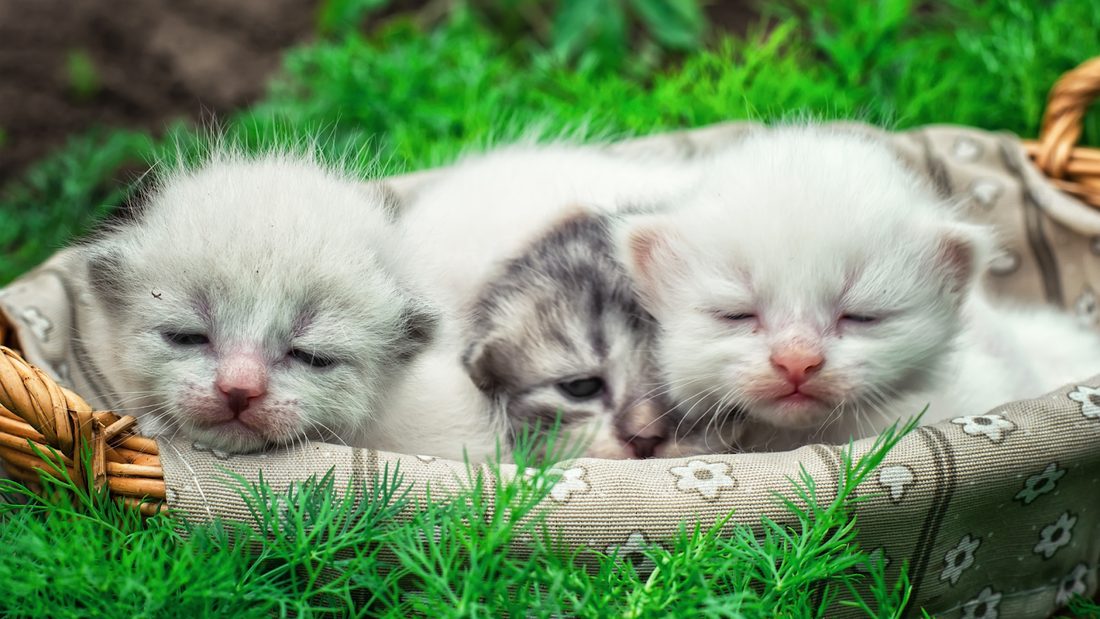A newborn kitten may be a thing of beauty when it’s brought into the world. However, there is a learning curve associated with taking care of them, especially when a mother is not present. The earliest weeks of a kitten’s life are by far the most critical, as they rely entirely on the care of their mother, especially when it comes to the milk needed for nutrition, immune support, and overall warmth.
There are situations when a mother cat might not be producing, rejects her litter, or may not be present at all. That’s where kitten milk replacer may be a good fit for their needs. We will discuss how you can find the best options that will ensure kittens get the best nutrition possible. You’ll also learn how to follow feeding schedules, proper techniques, and what to look for in a high-quality kitten formula.
What Is a Kitten Milk Replacer?
A kitten milk replacer is designed to mimic the nutritional profile of a mother cat’s milk. It’s packed with the necessary proteins, fats, vitamins, and minerals that are all critical to a kitten’s growth and development. High-quality replacers are available in liquid or powdered forms and are administered via a bottle or syringe. Also contained in mother’s milk is colostrum, which is antibodies that help protect newborn kittens from diseases. It contains essential fatty acids and nutrients that kittens need to grow in the beginning stages of their life.
Why Is Milk Replacer Necessary?
A milk replacer is always useful in numerous situations. The sooner you are aware of what it may be, the better you can act to ensure a kitten’s nutritional needs are addressed. Let’s take a look at the common situations where a kitten milk replacer option is necessary:
- The mother cat is absent or has passed away.
- She’s not producing enough milk.
- A kitten is rejected from the litter.
- Supplementing feedings for kittens who are weak or underweight.
- Fostering orphaned newborn kittens.
Choosing the best kitten milk replacer will be necessary in any of these situations. Not to mention, it can make a major difference between a thriving kitten and one that may be struggling. You may consider making an emergency kitten formula if you are unable to find a kitten replacer for the moment, although it should be used as a temporary solution.
Later on in this guide, we will go over three different recipes on how to make homemade kitten formulas. Because a kitten’s nutritional needs are critical, it’s a race against the clock whenever a kitten may not have access to nutrition, such as through a mother cat (and if you have no kitten formula immediately on hand).
What to Look for in Kitten Milk Replacer
Keep in mind that not all milk replacers are created equal. When looking for high-quality options, you’ll want to look for essential qualities that will stand out. Here’s what they are:
- Species-Specific Formula: Never use formulas such as cow’s milk, dog milk replacer, or plant-based milk options like soy or almond. Kittens have unique nutritional needs that differ from those of other species. Find a cat-specific milk replacer only.
- High-Quality Protein and Fat: Because kittens grow rapidly, they’ll need a formula that is rich in calories and has digestible fats and proteins. Consider ingredients such as whey protein concentrate, essential fatty acids like DHA, and animal fats. These will be critical for a kitten's growth, especially in the first few weeks of their life.
- Contains Taurine: This essential amino acid will be excellent for cats, especially when it can help with additional support pertaining to their eye and heart development.
- Balanced Calcium and Phosphorus: Bone development is also crucial, and calcium and phosphorus are two useful minerals that can help. Make sure you provide kittens with an appropriate amount. Too much or too little can lead to skeletal issues.
- Should Contain No Artificial Preservatives or Sweeteners: Artificial preservatives or sweeteners can irritate digestive systems or cause allergic reactions. As such, avoid these as much as possible. Instead, consider formulas that have limited and purposeful ingredients.
DIY Recipes for Kitten Milk Replacer at Home
There may be situations where kitten milk replacer may not be easily accessible. However, it is important to consider the alternative of creating a DIY kitten milk replacer. Once again, this can only be used for temporary purposes until you can find a kitten formula that is formulated specifically for kittens. Here are the following recipe options to consider:
Homemade Kitten Milk Replacer Recipe #1: Evaporated Milk Formula
Ingredients:
- 1 can (12 oz) evaporated milk
- 1 egg yolk (cooked or pasteurized)
- 1 tablespoon plain full-fat yogurt (unsweetened)
- 1 teaspoon light corn syrup (optional)
- 1 cup of water (boiled and cooled)
Instructions:
- Combine all ingredients. Blend or whisk until smooth.
- Warm gently to 100 degrees (F). Do not warm up in the microwave. Use warm water.
- Use within 24 hours. Refrigerate when not in use.
2. Goat Milk Formula
Ingredients:
- 1 cup whole goat milk (do not use raw goat milk)
- 1 egg yolk
- 2 tablespoons plain Greek yogurt
- 1 teaspoon of mayonnaise or coconut oil (both excellent fat sources)
- 1 drop of infant liquid multivitamins (without iron)
Instructions:
- Thoroughly mix the ingredients
- Serve in a warm kitten bottle or syringe. Remember to heat in warm water.
- Refrigerate leftovers and discard after 24 hours.
Goat milk can be an excellent option for kittens since it's easier to digest compared to cow’s milk. Still, the fat and vitamin content will be more than enough for newborn kittens.
3. Gelatin-Based Kitten Formula
Ingredients:
- 1 cup whole or goat milk
- 1 egg yolk
- 1 tablespoon unflavored gelatin
- 2 tablespoons full-fat plain yogurt
- 1 teaspoon light corn syrup
Instructions:
- Warm the milk and dissolve the gelatin.
- Add other ingredients and whisk until smooth
- Feed warm and store leftovers for up to 24 hours.
This can be an excellent option for kittens who may have trouble digesting other milk formulas. The gelatin is used for improving digestion. Only use whole milk because skim milk may not provide the necessary fat content needed for kittens.
Choosing a kitten milk replacement formula can be based on these three replacement options until you find the best commercial option. Still, kittens can get the essential vitamins they need from replacement formula in almost the same way as if they were fed by their mother.
Feeding Schedule and Appropriate Techniques
Whether you are using a homemade kitten milk replacer or a commercial formula, the feeding schedule and techniques are still the same. We will be taking a look at how you can feed kittens, including the amount they’ll need based on their age (in weeks). Here’s a look at the following schedule to follow:
|
Age (in Weeks of Age) |
Feedings Per Day |
Amount Per Feeding |
|
0-1 |
6-8 |
2-6 ml |
|
1-2 |
6 |
6-10 ml |
|
2-3 |
5 |
10-14 ml |
|
3-4 |
4 |
14-18 ml |
Please note that kittens should be fed belly-down. Never feed them on their backs as this can increase the risk of aspiration. Use a kitten-specific nursing bottle or a syringe, whichever is best. Warm the formula to 100 degrees (F) by placing the bottle in hot water for a few minutes. To ensure that it is at the appropriate temperature, test it on your wrist and make sure it’s hot.
After feeding the kitten, make sure you burp them gently. To do this, hold them upright and tap their backs gently and repeatedly.
What Signs Should You Look for if Kittens Don’t Tolerate Formula Well
Kittens may experience intolerance or illness, even if you are using a kitten milk replacer. As such, it is crucial to look for the following symptoms:
- Diarrhea or constipation
- Vomiting
- Lethargy or excessive crying
- Slow weight gain or weight loss
If these signs are present, you’ll want to consult your veterinarian as soon as possible. This might be a sign that kittens may need a prescription formula or something with hypoallergenic ingredients.
When Is the Best Time to Transition Kittens to Solid Foods?
Kittens may begin weaning from their mothers around the 4th week of their lives. This means you can begin the transition process of moving them from milk to solid foods. To start, mix wet food with formula and have them start eating it at a gruel-like consistency. Over time, reduce the amount of formula and increase solids.
At around 6 to 8 weeks of age, kittens may fully wean from their mothers. Likewise, they may be eating more solid foods around this time. Always use wet kitten food and avoid using hard kibble-like foods. Also, when looking for high-quality kitten foods, it’s important to look for the best ingredients. Refrain from any foods that have artificial flavors, added sugars, or unnecessary fillers.
Your Feline Raising Journey Begins with Under the Weather
This guide should be able to help you help a kitten who may not get the usual nutritional needs addressed through a mother cat. You now have an action plan to use in the event of taking care of a newborn kitten using milk replacers. While you wait for the commercial formula, make sure to take advantage of the homemade options listed above so you can immediately provide your kitten with the nourishment it needs to grow. As they grow up, Under the Weather will be here to handle their dietary and nutritional supplement needs from kittens to adulthood. Check out what we have available for your feline friend today.




